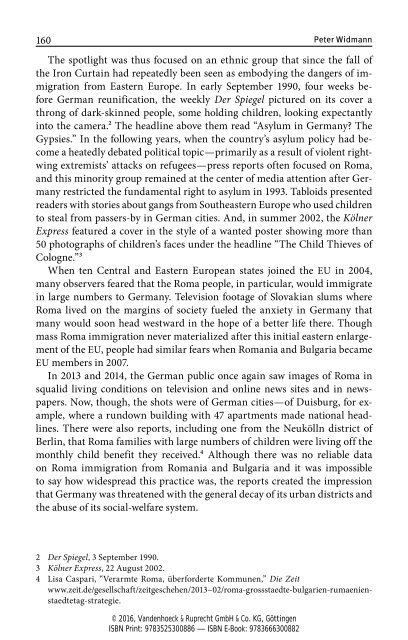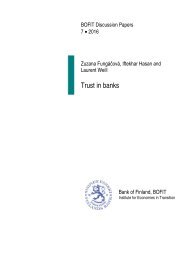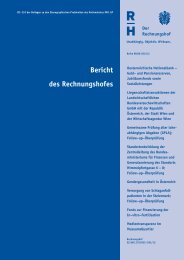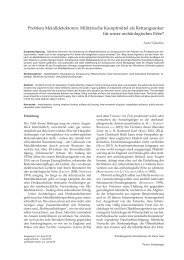Media and Minorities
9783666300882_ruhrmann_media_ebook_034247
9783666300882_ruhrmann_media_ebook_034247
You also want an ePaper? Increase the reach of your titles
YUMPU automatically turns print PDFs into web optimized ePapers that Google loves.
160<br />
Peter Widmann<br />
The spotlight was thus focused on an ethnic group that since the fall of<br />
the Iron Curtain had repeatedly been seen as embodying the dangers of immigration<br />
from Eastern Europe. In early September 1990, four weeks before<br />
German reunification, the weekly Der Spiegel pictured on its cover a<br />
throng of dark-skinned people, some holding children, looking expectantly<br />
into the camera.2 The headline above them read “Asylum in Germany? The<br />
Gypsies.” In the following years, when the country’s asylum policy had become<br />
a heatedly debated political topic — primarily as a result of violent rightwing<br />
extremists’ attacks on refugees — press reports often focused on Roma,<br />
<strong>and</strong> this minority group remained at the center of media attention after Germany<br />
restricted the fundamental right to asylum in 1993. Tabloids presented<br />
readers with stories about gangs from Southeastern Europe who used children<br />
to steal from passers-by in German cities. And, in summer 2002, the Kölner<br />
Express featured a cover in the style of a wanted poster showing more than<br />
50 photographs of children’s faces under the headline “The Child Thieves of<br />
Cologne.”3<br />
When ten Central <strong>and</strong> Eastern European states joined the EU in 2004,<br />
many observers feared that the Roma people, in particular, would immigrate<br />
in large numbers to Germany. Television footage of Slovakian slums where<br />
Roma lived on the margins of society fueled the anxiety in Germany that<br />
many would soon head westward in the hope of a better life there. Though<br />
mass Roma immigration never materialized after this initial eastern enlargement<br />
of the EU, people had similar fears when Romania <strong>and</strong> Bulgaria became<br />
EU members in 2007.<br />
In 2013 <strong>and</strong> 2014, the German public once again saw images of Roma in<br />
squalid living conditions on television <strong>and</strong> online news sites <strong>and</strong> in newspapers.<br />
Now, though, the shots were of German cities — of Duisburg, for example,<br />
where a rundown building with 47 apartments made national headlines.<br />
There were also reports, including one from the Neukölln district of<br />
Berlin, that Roma families with large numbers of children were living off the<br />
monthly child benefit they received.4 Although there was no reliable data<br />
on Roma immigration from Romania <strong>and</strong> Bulgaria <strong>and</strong> it was impossible<br />
to say how widespread this practice was, the reports created the impression<br />
that Germany was threatened with the general decay of its urban districts <strong>and</strong><br />
the abuse of its social-welfare system.<br />
2 Der Spiegel, 3 September 1990.<br />
3 Kölner Express, 22 August 2002.<br />
4 Lisa Caspari, “Verarmte Roma, überforderte Kommunen,” Die Zeit<br />
www.zeit.de/gesellschaft/zeitgeschehen/2013–02/roma-grossstaedte-bulgarien-rumaenienstaedtetag-strategie.<br />
© 2016, V<strong>and</strong>enhoeck & Ruprecht GmbH & Co. KG, Göttingen<br />
ISBN Print: 9783525300886 — ISBN E-Book: 9783666300882







